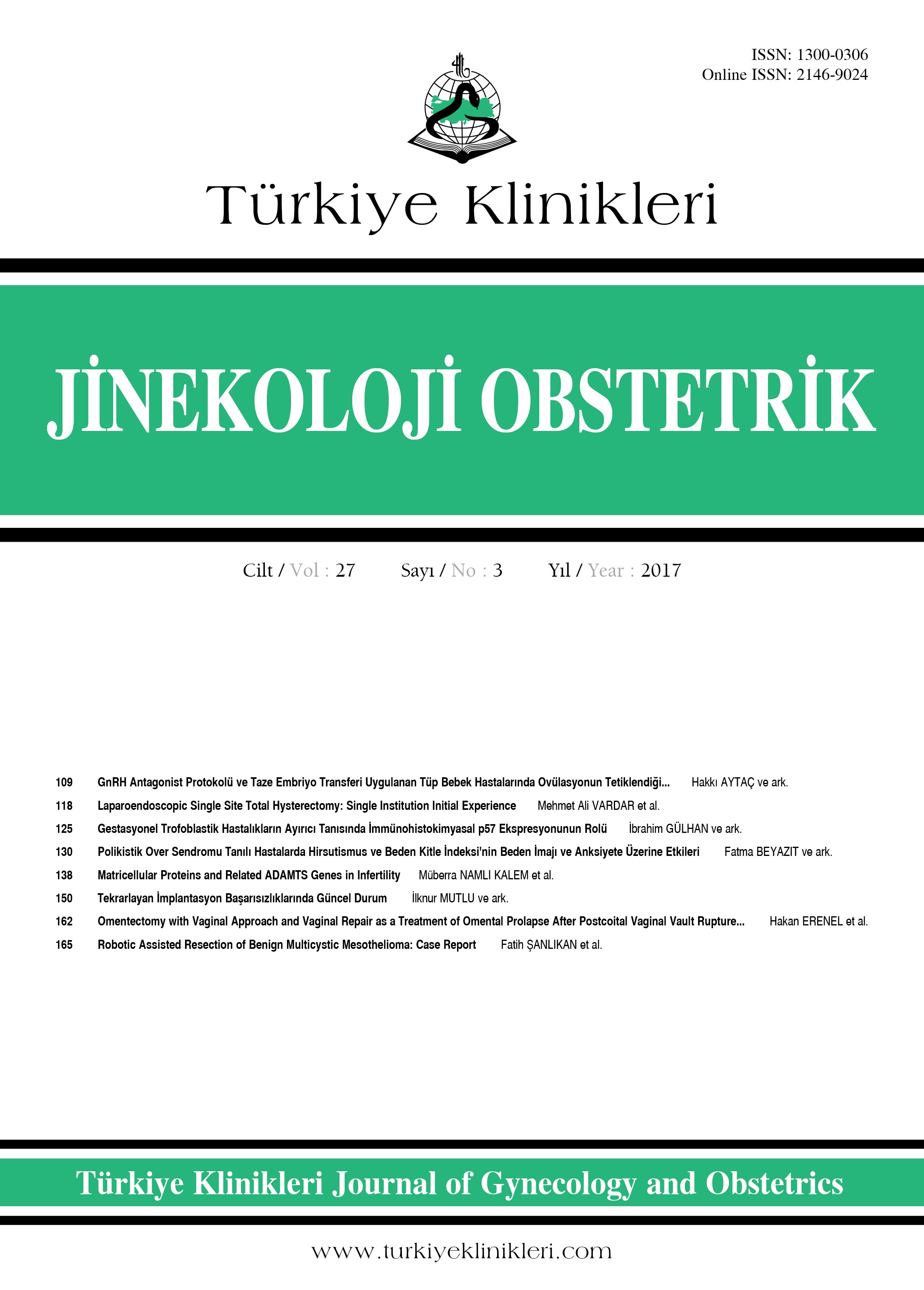Open Access
Peer Reviewed
REVIEW
3022 Viewed1570 Downloaded
Matricellular Proteins and Related ADAMTS Genes in Infertility
İnfertilitede Matrisellüler Proteinler ve İlişkili ADAMTS Genleri: Review
Turkiye Klinikleri J Gynecol Obst. 2017;27(3):138-49
DOI: 10.5336/gynobstet.2015-45243
Article Language: EN
Article Language: EN
Copyright Ⓒ 2025 by Türkiye Klinikleri. This is an open access article under the CC BY-NC-ND license (http://creativecommons.org/licenses/by-nc-nd/4.0/)
ABSTRACT
The human reproductive system is more sensitive than other species to functional disorders. Each organ in the system should function properly in the process of fertilization. Data of recent genetic studies suggest a critical role of multiple genes in various reproductive organs and tissues. Even though scrutinizing studies about all macro- and microprocesses in fertility are yet being held, and the system is trying to be untangled, the pathophysiology of infertility remains an appealing subject to research, which encircles the known sieged by unknown. The extracellular matrix (ECM) is not only a structural support for the cells, but also is a functional mesh which has determining role in cellular shapes, behaviors, differentiation, proliferation, gene expressions, and their life cycles. Matricellular proteins are members of extracellular matrix which functions in regulation of cellular reactions, cell-to-cell and cell-matrix interactions via providing the interplay among structural macromolecules, growth factors, cytokines, and proteinases. A Disintegrin-like And Metalloproteinase with Thrombospondin type-1 motif (ADAMTS) proteins are a group of zinc-dependent metalloproteinases responsible for degradation of ECM structures, which significantly act in many physiologic and pathologic processes. We aimed, in this review, to pose a broad view about the pathophysiology of infertility gathering the studies pertaining to matricellular proteins and ADAMTS enzymes which participate in the riddle of matrix breakdown and renewal.
The human reproductive system is more sensitive than other species to functional disorders. Each organ in the system should function properly in the process of fertilization. Data of recent genetic studies suggest a critical role of multiple genes in various reproductive organs and tissues. Even though scrutinizing studies about all macro- and microprocesses in fertility are yet being held, and the system is trying to be untangled, the pathophysiology of infertility remains an appealing subject to research, which encircles the known sieged by unknown. The extracellular matrix (ECM) is not only a structural support for the cells, but also is a functional mesh which has determining role in cellular shapes, behaviors, differentiation, proliferation, gene expressions, and their life cycles. Matricellular proteins are members of extracellular matrix which functions in regulation of cellular reactions, cell-to-cell and cell-matrix interactions via providing the interplay among structural macromolecules, growth factors, cytokines, and proteinases. A Disintegrin-like And Metalloproteinase with Thrombospondin type-1 motif (ADAMTS) proteins are a group of zinc-dependent metalloproteinases responsible for degradation of ECM structures, which significantly act in many physiologic and pathologic processes. We aimed, in this review, to pose a broad view about the pathophysiology of infertility gathering the studies pertaining to matricellular proteins and ADAMTS enzymes which participate in the riddle of matrix breakdown and renewal.
ÖZET
İnsan üreme sistemi işlevsel bozukluklara diğer türlere kıyasla daha duyarlıdır. Fertilizasyon sürecinde kadın reprodüktif organlarından her biri görevini tam olarak yerine getirmelidir. Güncel genetik çalışmalarından elde edilen bilgilere göre pek çok gen çeşitli üreme organ ve dokularında hayati rol oynamaktadır. Fertilitenin tüm makro- ve mikro-süreçlerinde yoğun araştırmalar devam etmesine ve sistem çözülmeye çalışılmasına rağmen, infertilite patofizyolojisi halen tüm bilinmezliğiyle karşımızda durmaktadır. Ekstraselüler matriks (ECM) hücreler için yapısal bir destek olmasının yanısıra hücrenin şekli, davranışı, diferansiasyonu, proliferasyonu, gen ekspresyonu ve hayatiyetleri üzerinde belirleyici rolü olan fonksiyonel bir dokudur. Matrisellüler proteinler ECM'ye ait elemanlardır; görevleri yapısal makromoleküller ile büyüme faktörleri, sitokinler ve proteazların etkileşimini sağlayarak hücre fonksiyonunu, hücreler arası etkileşimi ve hücre-ECM etkileşimini regüle etmektir. ''A Disintegrin-like And Metalloproteinase with Thrombospondin type-1 motif'' (ADAMTS) proteinleri, ECM yapılarının yıkımından sorumlu, vücutta birçok fizyolojik ve patolojik süreçte önemli rolleri olan çinko bağımlı proteinazlardır. Bu derlemenin amacı infertilite patofizyolojisinde matrisellüler proteinlerin ve ilgili ADAMTS'lerin rolleri üzerine yapılmış çalışmaları biraraya getirerek konuyla ilgili geniş bir perspektif sunmaktır.
İnsan üreme sistemi işlevsel bozukluklara diğer türlere kıyasla daha duyarlıdır. Fertilizasyon sürecinde kadın reprodüktif organlarından her biri görevini tam olarak yerine getirmelidir. Güncel genetik çalışmalarından elde edilen bilgilere göre pek çok gen çeşitli üreme organ ve dokularında hayati rol oynamaktadır. Fertilitenin tüm makro- ve mikro-süreçlerinde yoğun araştırmalar devam etmesine ve sistem çözülmeye çalışılmasına rağmen, infertilite patofizyolojisi halen tüm bilinmezliğiyle karşımızda durmaktadır. Ekstraselüler matriks (ECM) hücreler için yapısal bir destek olmasının yanısıra hücrenin şekli, davranışı, diferansiasyonu, proliferasyonu, gen ekspresyonu ve hayatiyetleri üzerinde belirleyici rolü olan fonksiyonel bir dokudur. Matrisellüler proteinler ECM'ye ait elemanlardır; görevleri yapısal makromoleküller ile büyüme faktörleri, sitokinler ve proteazların etkileşimini sağlayarak hücre fonksiyonunu, hücreler arası etkileşimi ve hücre-ECM etkileşimini regüle etmektir. ''A Disintegrin-like And Metalloproteinase with Thrombospondin type-1 motif'' (ADAMTS) proteinleri, ECM yapılarının yıkımından sorumlu, vücutta birçok fizyolojik ve patolojik süreçte önemli rolleri olan çinko bağımlı proteinazlardır. Bu derlemenin amacı infertilite patofizyolojisinde matrisellüler proteinlerin ve ilgili ADAMTS'lerin rolleri üzerine yapılmış çalışmaları biraraya getirerek konuyla ilgili geniş bir perspektif sunmaktır.
MENU
POPULAR ARTICLES
MOST DOWNLOADED ARTICLES





This journal is licensed under a Creative Commons Attribution-NonCommercial-NoDerivatives 4.0 International License.










